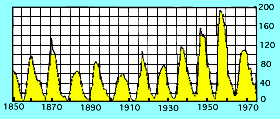|
Ultimately, however, Schwabe's article caught the eye of Alexander von Humboldt, tireless promoter of the sciences, who in 1851 published Schwabe's table (updated to 1850) in his encyclopaedic compilation of natural science, "Kosmos." After that scientists all over the world became interested in the 11-year sunspot cycle. Some, led by Rudolf Wolf, examined old records to reconstruct earlier sunspot cycles, while Edward Sabine in England in 1852 found a similar periodicity in magnetic storms. Some more speculative minds also claimed (and still do) an 11-year period in weather patterns, or even in the outbreaks of wars and epidemics.

Sunspot Cycle (1850 - 1975)
Flares
One who was greatly influenced by Schwabe's discovery was an English gentleman of independent means, Richard Christopher Carrington, who devoted himself to the study of sunspots. His work, extending from 1853 to 1861, was collected in "Observation of the Spots of the Sun" [1863], a book described by Harold W. Newton as "a classic studied with feelings of admiration by all sunspot observers." Carrington was busily observing a prominent group of sunspots on September 1, 1859, when suddenly "two patches of intensely bright and white light broke out." The patches brightened rapidly and then decayed again (click here for his description) and by good chance, the observation was confirmed by another English astronomer.
Carrington had seen a flare, of the rare variety that is visible in white light (only about 50 are known). No more than 17 hours later a great magnetic storm erupted, with aurora seen as far as Cuba. Carrington noted the connection, but cautioned that "one swallow does not make a summer."
In 1892 George Ellery Hale--founder of the great astronomical observatories on Mt. Wilson and later on Mt. Palomar--devised the spectroheliograph, an instrument scanning the Sun in a narrow range of color emitted by a certain atom ("spectral line"). In July of that year he used it to observe two large flares, followed (19.5 and 30 hours later, respectively) by big magnetic storms. Hale also tuned his instrument to spectral lines known to change when produced in strong magnetic fields, and concluded in 1908 that sunspots were intensely magnetic. That fit nicely with observations during total eclipses of the Sun, when streaks above sunspot areas were often seen to arch above the Sun's edge like field lines of a bar magnet.
After World War II scientists began monitoring the cosmic radiation, the flow of high-energy ions arriving from distant space, using arrays of Geiger counters and other instruments. Starting in 1942 they occasionally saw peaks of intensity after strong flares. Flares also emit x-rays, believed to be produced by great numbers of high-energy electrons accelerated in the flare region and trapped in it. The GOES spacecraft regularly monitors such emissions, and x-ray cameras aboard satellites--e.g the Solar Maximum Mission, launched in 1980, and more recently Yohkoh, launched in 1991--have taken some remarkable flare pictures.
Coronal Mass Ejections
Coronal mass ejections (CMEs), described earlier, were observed by the space station Skylab in 1973, following earlier indications from the 7th Orbiting Solar Observatory (OSO 7). However, nearly 20 years passed before Art Hundhausen and Jack Gosling collected convincing evidence that perhaps CMEs, rather than solar flares, may be more characteristic phenomenon of abrupt energy release. We still lack a good explanation of what propels those giant plasma clouds away from the Sun.
Further Explorations:
- Biography of Heinrich Schwabe
- "Explorer of the Universe: A biography of George Ellery Hale" by Helen Wright, Dutton & Co., 1966 (republished by Amer. Inst. of Physics, 1994, 487 pp, $29.95 hard cover)
- "Early Solar Physics" by A.J. Meadows, Pergamon Press, 1970.
- "The New Solar Physics" by John A. Eddy, Westview Press, Boulder, 1978
Questions from Users:
***
About the Upcoming Solar Maximum
|
